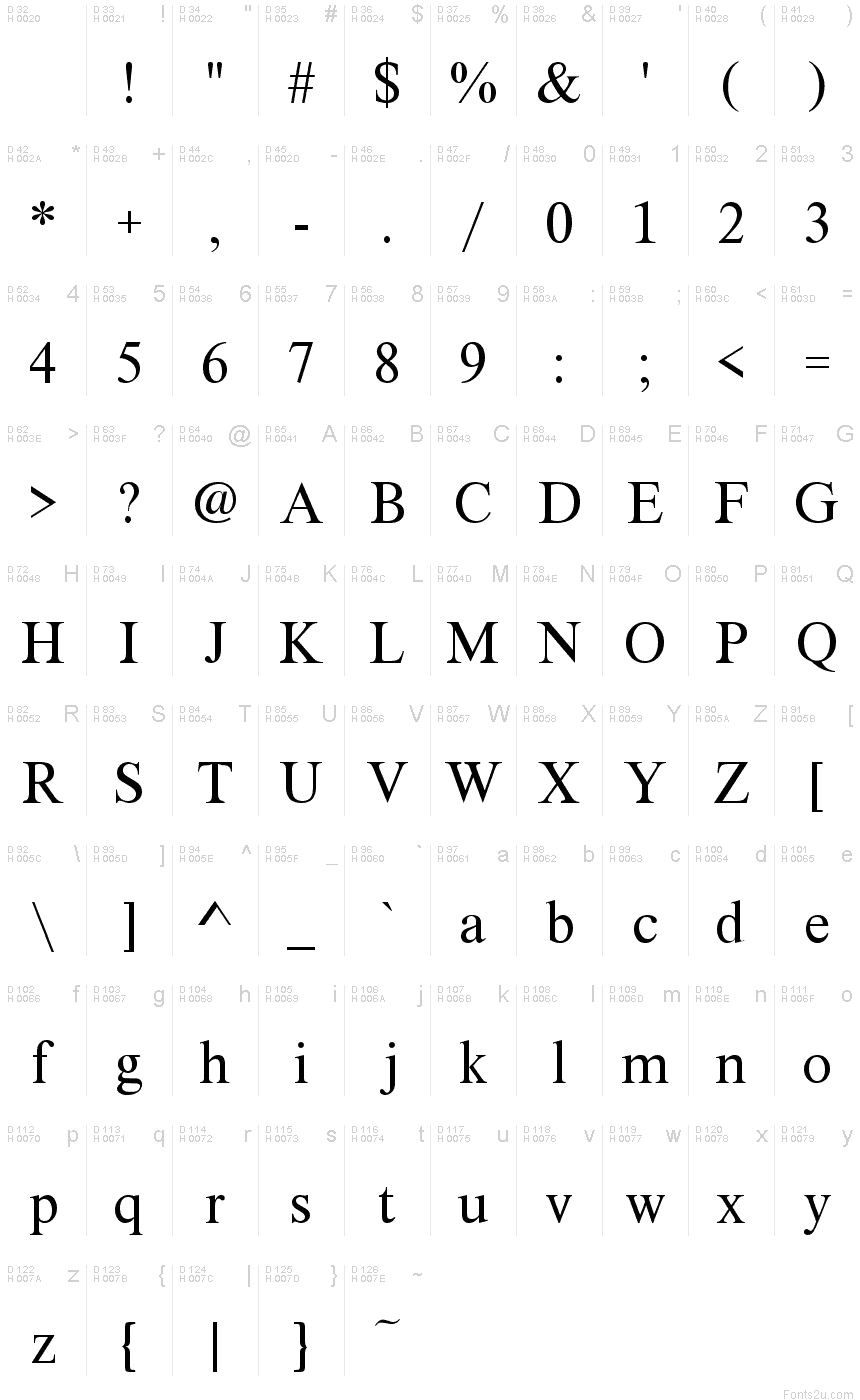XSerif Unicode
TrueTypeZum persönlichen Gebrauch
- Akzente (teilweise)
- Akzente (ganz)
xsuni.ttf
Stichworte
Zeichentabelle
Benutzen Sie bitte das Pull-Down Menü um verschiedene Zeichentabellen, die in dieser Schriftart enthalten sind, zu sehen.

Standard Schriftarten Information
Urheberrechte
(c) Ch. Singer 1997. Use Font Property Extension to read License table.
Schriftfamilie
XSerif Unicode
Schriftunterfamilie
Regular
Einzigartige Unterfamilieidentifikation
DTP- XSerif Unicode Version 1
Vollständiger Schriftname
XSerif Unicode
Name-Tabelle Version
Version 1.00
Postscript-Schriftbezeichnung
XSerifUnicode
Schutzmarken
Created by Type-Designer 3.0
Hersteller
Beschreibung
In addition to the codepages mentioned in "Charset/Unicode" table, this font contains Old Russian characters (Yat', Fita, Izhitsa) and combining diacritical marks with it's right UNICODE numbers.
There are also further characters used by Trediakovskij in 18 century and some characters for transliteration in user defined UNICODE area.
You can use these characters only if you have a UNICODE-based text processor (e.g. MS Word 97).
XSerif Typeface
When I wanted to create some special fonts for students of slavistics (e. g. for transliteration an Old Russian) I looked for a font with a "Times®"-like typeface that I could use as a base for my new fonts. But I found that all quality fonts are copyrighted and the quality of free and public domain fonts on Internet didn't please me, so I decided to create a new font with a slightly changed "Times®"-like typeface that I called "XSerif". Most common letters as "A" or "H" probably look like they do in every similar typeface, except slightly different poportions, serifs and weight, but some letters as cyrillic "zh" or cyrillic "l" are originally designed because I didn't like their shape in other "Times®"-like typefaces.
There is only Regular typeface existing at this time.
If you are looking for a base font to create fonts containig special characters you can use XSerif fonts under the two conditions described in "License" table.
There are also further characters used by Trediakovskij in 18 century and some characters for transliteration in user defined UNICODE area.
You can use these characters only if you have a UNICODE-based text processor (e.g. MS Word 97).
XSerif Typeface
When I wanted to create some special fonts for students of slavistics (e. g. for transliteration an Old Russian) I looked for a font with a "Times®"-like typeface that I could use as a base for my new fonts. But I found that all quality fonts are copyrighted and the quality of free and public domain fonts on Internet didn't please me, so I decided to create a new font with a slightly changed "Times®"-like typeface that I called "XSerif". Most common letters as "A" or "H" probably look like they do in every similar typeface, except slightly different poportions, serifs and weight, but some letters as cyrillic "zh" or cyrillic "l" are originally designed because I didn't like their shape in other "Times®"-like typefaces.
There is only Regular typeface existing at this time.
If you are looking for a base font to create fonts containig special characters you can use XSerif fonts under the two conditions described in "License" table.
Erweiterte Schriftarten Information
Unterstützte Plattformen
PlattformKodierung
MicrosoftNur BMP Unicode
MacintoshWestliche (römische)
UnicodeUnicode 1.0 Semantik
Schriftdetails
Kreiert1998-04-09
Änderung1
Zeichenzahl463
Einheiten pro Em2048
Einbindungs RechteEinbindung für Festinstallation
Familien GattungFreiförmige Serifen
StärkeMittel leicht
BreiteMittel
BreitentypStandard
Mac StyleFett
RichtungNur stark von Links nach Rechts gehende Schriftzeichen
Muster BeschaffenheitRegelmäßig
HaltungGerade
Strich StärkeBook, Text, Standard, etc.
AbstandUngleicher Abstand